Mystery Fish Postcard Solved? Megamouth?
Posted by: Loren Coleman on May 29th, 2007
Could the solution of the mystery fish photograph on an antique postcard (first noted at Cryptomundo on November 29, 2005) be at hand? Could this postcard reveal evidence of a beached megamouth shark decades before the species was officially verified?
(Click on image to see full size version the Mystery Fish Photo postcard, enhanced by shockbeton)
Mystery Fish head, click to enlarge.

Does the head of the megamouth look similar to that of the Mystery Fish’s head from the old postcard?

The above photograph (and the one below) of this 2004 megamouth are courtesy of Ton & Marjan of the Lumba Lumba Diving Centre, and used with their permission.
The megamouth shark was unknown to established zoology until 1976, when a Naval Undersea Center team from the Hawaii Laboratory made a chance catch. They were working around the Hawaiian Islands, spending a few days aboard a research vessel, and carrying out surveys in the deep waters. Two large parachutes, dropped overboard to a depth of 500 feet, served as sea anchors.
On the day of the team’s departure they hauled in the parachutes, only to discover that they had caught a gigantic shark. It measured 14.5 feet in length and weighed 1,650 pounds.
Leighton R. Taylor, director of the University of Hawaii’s Waikiki Aquarium, recognized it as a heretofore-unsuspected new species.
The media soon dubbed the creature “Megamouth,” due to its extremely large mouth. The mouth of a megamouth is so huge, over four and a half feet wide and extending back behind the shark’s eyes, that a small diver with gear could swim into it. Taylor and his colleagues incorporated the name “Megamouth” in the species’ 1983 scientific description, christening it Megachasma pelagios (“great yawning mouth of the open water”).
Even though the fossil record never even hinted at the existence of such an animal, the discovery of the megamouth caused hardly a ripple in the world of marine science, as Patrick Huyghe and I noted in our 2003 field guide on such matters.
The location for the photo on the postcard shows palm trees, and match where some of the strandings of megamouths have occurred.
Compare the body’s shape and linear patterns of the megamouths with the image of the Mystery Fish on the old postcard shared with me in 2005 by Cryptomundo reader Phyllis Mancz of Ohio.
Postcard, click to enlarge.
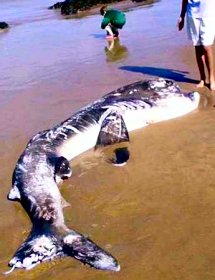
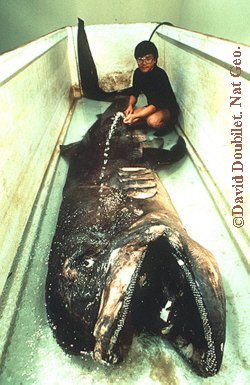
Megamouths sometimes show a strange side body hatching, as seen on the Mystery Fish.
Here is a roundup of direct links to the “Mystery Fish Photo” entries in the Cryptomundo.com blog, which were posted in 2005 and 2006:
“Name the Mystery Fish Continued”
Almost four hundred comments, most of them extremely thoughtful and detailed, can be found at the above noted entries, and yours are welcome anew, here, below. Perhaps someone, in passing, mentioned the megamouth before. But in almost 2,500,000 views of the Cryptomundo “Mystery Fish” photo, no one before Steve Bloomfield sent in compelling photos that suggested a match, as he did recently.
Mystery Fish enhancement, click for full-size version, provided by Todd DiLaMuca.
Now, again, compare the head enhancements of the postcard’s Mystery Fish with that of the megamouths found on beaches.
(Click image for full-size version)
(Click image for full-size version, provided by Todd DiLaMuca)
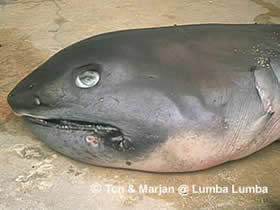
Megamouth, 2004, forwarded by Steven Bloomfield.

Another megamouth.
+++Date of the Postcard++++
The earlier discussions noted the date was between 1904-1918 for this postcard. For example, in this hyperlinked blog (please click), the entire back of the postcard is pictured. Various pieces of research exactly determined that the diagnostic direction of the triangles give forth with a specific range of when these postcards were produced. While the men and the fish could have been photographed before 1904, they could not have been photographed and appeared on this card after 1918.
The window of time for the production of this postcard is, therefore, most probably, between 1890 and 1918. But certainly, this photograph was not taken anytime after 1918, years before the megamouth was even considered as part of the reality of the marine world.
^^^^^^^^^^^^^^^^^^^^^^^^
Thanks again to Steve Bloomfield.
About Loren Coleman
Loren Coleman is one of the world’s leading cryptozoologists, some say “the” leading living cryptozoologist. Certainly, he is acknowledged as the current living American researcher and writer who has most popularized cryptozoology in the late 20th and early 21st centuries.
Starting his fieldwork and investigations in 1960, after traveling and trekking extensively in pursuit of cryptozoological mysteries, Coleman began writing to share his experiences in 1969. An honorary member of Ivan T. Sanderson’s Society for the Investigation of the Unexplained in the 1970s, Coleman has been bestowed with similar honorary memberships of the North Idaho College Cryptozoology Club in 1983, and in subsequent years, that of the British Columbia Scientific Cryptozoology Club, CryptoSafari International, and other international organizations. He was also a Life Member and Benefactor of the International Society of Cryptozoology (now-defunct).
Loren Coleman’s daily blog, as a member of the Cryptomundo Team, served as an ongoing avenue of communication for the ever-growing body of cryptozoo news from 2005 through 2013. He returned as an infrequent contributor beginning Halloween week of 2015.
Coleman is the founder in 2003, and current director of the International Cryptozoology Museum in Portland, Maine.

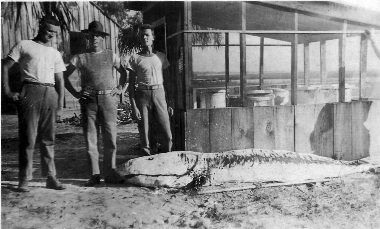

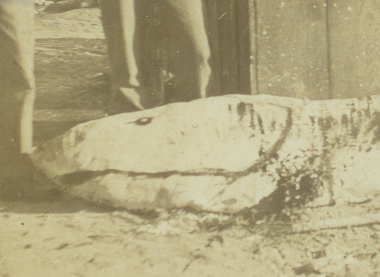









IMO the postcard fish is nothing more than a bad attempt at a gaff, complete with painted on eye, mouth and markings.
I’ve been seeing this “fish” for almost 2 years now and it looks no more real now than it ever did.
Nice observation of the dates. Years often escape my attention:)
I can certainly see similarities, but the eyes still look different to me and the “mystery fish” does not have any obvious gills whereas the megamouth does. The mystery fish also has a more pointed snout that seems to be longer than a megamouth. There is also the issue of fins, although it has been speculated before that these could have been removed. I think the skin looks different too. Although this It is very thought provoking, but I still don’t see a match. Can’t wait to see what other posters here have to say about this.
It’s intriguing. A mutilated megamouth might fit, although what looks like the jaw line on the mystery fish goes on much further (indeed, too far for it to be normal, if it is in fact a jawline).
I don’t know. If it’s a definned or mutilated shark then one of the pics looks more like a tiger shark to me. The blunt, almost squared off snout resembles a tiger shark, but the eyes are wrong.
Weird!
Looks more like one of the Giant Salamanders – it’s head doesn’t seem to be the same shape as that of the Megamouth. It also seems to have the “beady little eyes” of most of the giant salamanders.
I agree that the eyes don’t seem to match. There are other details that to me don’t look like the same creature. Intriguing proposal, but I have my doubts.
Although its a good guess I don’t think the megamouth is a match – there are no gill slits on the mystery fish. And if the mystery fish were a skinned shark the gill slits or the underlying gill structure should still be visible.
I think the following newspaper story, if true, is a better candidate for the picture.
Possibly. I can see how the mystery fish might be a deformed megamouth shark due to mild decomposition. Let’s not forget that a partially decomposed basking shark can resemble a plesiosaur and a partially decomposed humpack whale can look like a giant sea turtle. Partial decomposition might deflate the MF giving its head a squarish outline and make its eyes appear more almond like. The MF’s angle away from the camera can hide the dorsal fin from view giving it an eel like appearance. Notice though that the skin pattern is identical to that of a megamouth.
It’s still tough, perhaps a new species, but I was thinking along the lines of a Crocodile Shark (Pseudocarcharias Kamoharai) a deep water shark.
Hmmm… I don’t see the crocodile shark resemblance. Looking that one up, it’s much too small (adults are only 4-6 kg) and has quite a sharp snout.
I think the old postcard photo has been retouched, not very skillfully, with an inkpen — a common enough practice in those days. If you compare the resolution of the “mouth” line and the contrast of the fish’s (?) body with the rest of the photo, it almost appears as though it’s been enhanced, maybe through ink and a couple of old-time darkroom techniques called foxing and dodging.
I admire the Megamouth hypothesis and think it’s possible. The shape of the snout, though, is a problem.
This is what I always see when looking at the head of this thing.
The lack of fins and the square head did it for me, the thing is a fake. It looks like a painted flour sack to me.
I don’t know why they wanted to fake this, or what it’s supposed to be, but it’s fake.
Maybe it’s just me, but I don’t see any resemblance between the Megamouth & The Mystery Fish at all.
I maintained last year that this was a bony fish; further, that the photo was taken near San Juan, Del Sur, Nicaragua. I still think that is the case.
As regards Megamouth – I agree with a_welch90 – beached megamouths generally have their mouths spread all over the ground, they are that large.
The one beached magamouth in this article that doesn’t have it’s mouth wide open is a tiny individual – not the large size of the fish in the postcard.
I disagree with anyone who thinks it’s a fake though.
It looks too reptilian too me to be a shark. The head looks snake like and the eyes look like that of a skink. I do like the Giant Salamander idea though.
The megamouth is similar in shape and size, but I do not buy it. There are enough subtle differences that have been stated above, plus the shape of the megamouth head is more bulbous and the mystery fish is definitely oblong or more rectangular in shape.
The lower bottom jaw of the mega mouth is much more rounded…yes, I know the mystery fish is laying on its stomach, but still there is no rounded-ness even suggested by the mystery fish–the lower jaw is jutting and rectangular in shape.
And the mystery fish has a much more reptilian/salamander look to it whereas the mega mouth, while odd in its own right, has a lot more fish appeal.
No, I do not believe it is a mega mouth.
It’s still difficult to ascertain what “The Mystery Fish” is. Megamouth Shark is a good guess but like the other posts I don’t see it as the answer. Speculation continues.
The postcard looks like it was retouched, but that might be it’s age. It doesn’t look anything like a megamouth though. I would guess it was just a fake picture like most of the mystery animal postcards from back then.
If we only knew what sort of teeth this mystery fish had, it would certainly lead to a proper identification. The mouth does appear wide, the morphology of what we see of the body would indicate it`s a bottom feeder, some sharks like a type of nurse shark, but in those species i don`t know of any round snouts
While I see some similarities with a Megamouth, when looking at the photos side-by-side I really have to say they look like two different animals to me. As good a guess as any, I think, to say a Megamouth but I still don’t think we can call this one ‘case closed’
Your perspective is wrong on this photo.
The view of the shark is from the top and not the side.
What you think is a mouth is actually a blood smear that leaked from its gill and trailed down the top of its head, likely from the position it was in before the photo (possible hung by the tail).
One sign is that the blood smear obviously ends before it reaches the end of head. If it was a mouth it would go all the way to the edge and disappear around to the other side.
ALSO, the tail fin is completely wrong for a side view BUT in correct position for viewing shark from top.
Shark tail fins go top to bottom and shark moves it side to side for movement.
With this new perspective, reanalyze the photo and you will see where everything else is suppose to be,dorsal fin, gills, etc.
Thank you ahead of time for your intellectual thought and consideration.
tanaraq- And you are absolutely sure of that? That idea was brought up many times before on the previous threads about this photo and the idea does have merit, but from the evidence at hand (this one photo) it is just a theory like the others here and as such seems a bit hasty to say that everyone’s perspective is downright wrong. Although it is a good hypothesis, a few things give me pause with that idea. First of all, the lateral line, which would presumably be the side of the creature is precisely where it should be when looking at it from the perspective you claim is wrong. Also, look at the cut that was made when cleaning the thing. That cut is typically made at the bottom along the stomach and so it would be an oddly placed cut if this were indeed a perspective from the top. That would mean someone had cut along its back, which leads me to ask how likely that is.
I don’t see what you mean about the tail. If this fish is a shark and laying on its side, the tail is still in a proper position to be a shark’s tail as it appears to me that in the perspective from the side, the tail (what’s left of it, if that is even really the tail) goes top to bottom. The idea of this being a top down perspective is intrigueing and I haven’t discounted that idea, but it still has its problems and there is nothing to say that it is absolutely right.
That being said, I do agree that a streak of blood makes the mouth appear longer but this still does not prove the perspective of the fish to me.
If it is even a fish, I should add! 🙂
I’m still puzzled by the right angle that shows just behind what might be the mouth or whatever line. There is a dead straight vertical line that meets a shorter dead straight horizontal line. That alone has me thinking this is likely an old cut and paste retouching job. Mystery Man is that what you meant by the cut made to clean it?
Ceroill- Yeah. I could be wrong of course, but to me it looks ike this thing was cut open and gutted which leads me to believe that is the bottom of the creature in question.
It could also be an optical illusion and I’m just seeing things from staring at this blasted picture too long! 🙂
I’m starting to think that this very well could be a top down view of the thing. I’ve gone back and forth on the perspective thing with this picture. One thing I do think for certain is that in my opinion this is not a megamouth shark!
Thanks Mystery Man, I was just curious if we were noticing the same thing.
I don’t see this as a top view, unless it’s a pasted composite of head and body. As far as I can tell the head is being seen from an angle consistent with it laying more or less on its side. The head looks very snake-like to me. The body I can’t really tell.
Although if it IS a real animal, that is most certainly what it is. I don’t believe it is. I see no clear connection between the head and the body, leaving me to believe its the head of one animal, layed upon the body of another. Nothing more than a joke they played to make people think they found some wierd creature.
I would say that the megamouth is a possible match but even with slight decomposition seems unlikely. The skin on this animal is more like a fur coating than anything else, which leads me to believe that it is possibly a seal? At least a sea lion with some decomposition, plus the reason for the head sitting so unfirmly upon the rest of the body is that if you look closely you can clearly see that the throat of this animal has been cut. Therefore I believe that it is not a fish at all but in fact a mammal which has been slightly mutilated and decomposed. What do you guys think?
it looks like an earlier version of the megamouth shark before it grew fins.
It could be an oarfish??
Wow… Kinda funny that we still haven’t found an answer for this..
-Fang: I don’t think it would take that little time for the Megamouth to evolve fins, especially considering that all known species of sharks have fins: without fins, it’s a lot more like a hagfish with jaws than a shark.
-Jessiemunster: Eh, I think the oarfish would be a bit thinner than what we see here.
I’m still saying this thing looks reptilian, but I don’t think we’re seeing a complete animal, either. Little bit of slice’n’dice?